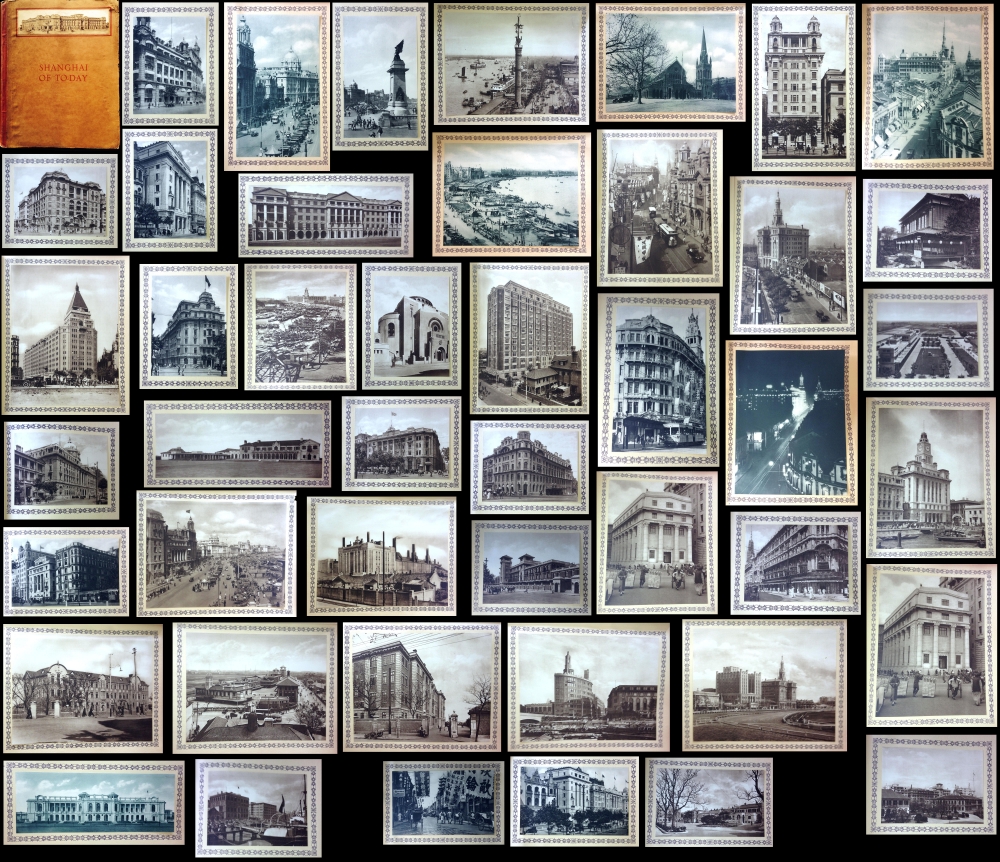1930 Shanghai of To-Day Photo Book (50 Photos)
ShanghaiToday-kellywalsh-1930-2
Title
1930 (dated) 12.5 x 10 in (31.75 x 25.4 cm)
Description
A Closer Look
Following a short introduction by F. L. Hawkes Pott, the book features fifty tipped in photogravures offering various Shanghai street scenes and buildings. Most photos focus on the Bund and the International Settlement. The book was a gift from Frank L. Hill to Captain A. P. Sprange, a known British military officer active in Shanghai between World War I and II.The Bund
The Bund is a waterfront area in central Shanghai. The name is derived from the old German term, 'bund,' meaning simply embankment or causeway. Many Asian colonial cities supported a Bund, but none became more famous or iconic than the Shanghai Bund. The area centers on the section of Zhongshan Road within the former Shanghai International Settlement, which runs along the western bank of the Huangpu River, facing Pudong, in the eastern part of Huangpu District. The Bund usually refers to the buildings and wharves on this section of the road, as well as some adjacent areas. It is one of the most famous tourist destinations in Shanghai and a designated historic zone.Lining the Huangpu River, the Shanghai Bund has dozens of historical buildings that once housed important banks and trading housing from the United Kingdom, France, the United States, Italy, Russia, Germany, Japan, the Netherlands, and Belgium, as well as the consulates of Russia and Britain, a newspaper, the Shanghai Club, and the Masonic Club. The Bund lies north of the old walled city of Shanghai and was initially a British settlement. A building boom at the end of the 19th century and the beginning of the 20th century led to the Bund becoming the major financial hub of East Asia. The former French Bund, east of the walled city, was formerly more a working harbor.
Shanghai 1910 - 1932
The 1910s-20s were a golden age for Shanghai, at least in the Concessions. While China was ruled by Chiang Kai-shek, Shanghai was dominated by several consolidated foreign trade Concessions. Under the strict administrative control of the Concessions, the city became a cosmopolitan haven in the midst of political unrest and a center for global trade and finance. The Concessions occupied what is today central Shanghai's most desirable land, hugging the Huangpu River and Wusong River (Suzhou Creek). These extraterritorial European, Japanese, and American enclaves had modern housing, fine roads, streetcars, elegant shops, clubs, and more. It was a place of excess, art, and extravagance, where fortunes could be made by the enterprising - and lost by the foolish. Moreover, lacking the moral constraints that limited social life in Europe and America, Shanghai became a nexus for the opium trade, sexual excess, gambling, and other vices. This ephemeral world came crashing down on January 28, 1932, when the 'Shanghai Incident' or 'January 28 Incident' pitted the Republic of China against the Empire of Japan. Responding to Chinese student protests against the Japanese occupation of Manchuria, the Japanese Navy bombarded Shanghai. Chiang Kai-shek sent the Chinese army in to defend the Shanghai students, threatening to escalate the conflict. The League of Nations, fearing all-out war, united to demand a ceasefire, which was signed. Nonetheless, most consider The January 28 incident to be the opening salvo of the Second Sino-Japanese War (1938 - 1945) which ultimately merged into World War II.Publication History and Census
This volume was published by Kelly and Wash in Shanghai, China. The first edition appeared in 1928, followed by a second in 1929, and the present third edition in 1930. Earlier editions had view images, with the first edition having only thirty-eight and the present third edition offering fifty, making it more desirable. This volume is considered a staple for any collection of Old Shanghai imagery.Cartographer
Kelly and Walsh (1876 - present) was a Shanghai based and managed publishing concern founded in 1876. The firm was organized around the consolidation of the Yokohama and Shanghai based Kelly and Company, owned by the Irish printer John M. Kelly, and the Scottish booksellers F. and C. Walsh. The firm was formally incorporated in Hong Kong on July 1 of 1885, when it sold some 1350 shares, most to Thomas Brown, a Shanghai resident to acquired 1114 of the outstanding shares. The remainder were acquired by a variety of stationers ad printers a 11 Bund, Shanghai, presumably Kelly and Walsh employees as this was their operating address (later they relocated to 66 Nanking Road in 1918, with offices also at 12 Nanking Road). The firm was most active from the 1870s to the 1940s, when it expanded into a variety of related business: bookseller, stationer, publisher, printer, lithographer, book binder, die engraver, color stamper, India rubber stamp manufacturer, news agent, music seller, commission agent, and tobacconist. There is some evidence that Kelly was active in Providence, Rhode Island, acquiring partial interest in the firm of Bubee and Hall, but it is unclear if in divested of his Asian interests. By the outbreak of World War II they had offices in Hong Kong, Yokohama, Tokyo, Singapore and Hankou (Wuhan). When the Japanese occupied Shanghai, the firm moved its management offices to Hong Kong, where it was acquired by Swindon Book Company in the 1950s. The Singapore branch of Kelly and Walsh, established in the prestigious Raffles Palce, operated an English language bookshop through from about 1881 to about 1956, publishing more than 200 titles and having its own bindery. The firm still operates a small chain of swank bookstores in Hong Kong. More by this mapmaker...

